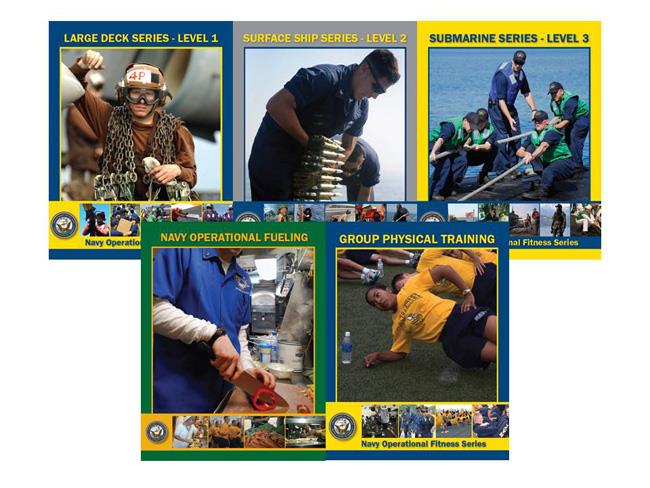1 - scroll top
2 - header search
Training Program Information
The pillar consists of the hips, torso and shoulders, which collectively represent the foundational structure for all movement. Pillar prep primes these three areas and corresponding muscles to prepare Sailors’ bodies for the work ahead, protect them from injury and enhance their performance potential during the training session.
Movement Preparation
Strength
Sailors need to optimize movement patterns and strengthen the muscles needed to perform on an operational platform. Close attention should be given to the quality of movement patterns. Sailors should select a resistance that is challenging based on the prescribed number of repetitions.
Cardiovascular Training
Endurance and speed can be enhanced through a variety of interval-based cardiovascular training blocks. Energy System Development (ESD) consists of movements and modalities designed to target and develop our energy systems and is an effective way to burn calories. Training zones are the building blocks of the interval workouts. Each cardio workout consists of one or more training zones; each zone represents a level of effort (e.g., easy, medium and hard). But how do you know you’re exercising at the right effort? You can perform these interval workouts by measuring your effort in one of two ways: (1) heart rate, or (2) rate of perceived exertion.
Heart Rate Training - One way to calculate your training zones is based on your maximum heart rate (Max HR). If you have a heart rate monitor, you can measure your heart rate as you train to stay in each zone. If you don’t know your Max HR, you can estimate it by using this formula: Max HR = 220 - your age. Once you’ve calculated your approximate Max HR, use the percentages below to determine your heart rate training zone for each interval.
Rate of Perceived Exertion- Your rate of perceived exertion (RPE) is a simple and effective way to determine your training intensity when performing intervals. RPE uses a scale of 1-10 to rate your effort. A rating of 1 is equivalent to standing still, while a rating of 10 represents the most strenuous level of activity you can sustain. Use these general guidelines to put forth the right effort for each interval.
Regeneration (Cool Down, Stretch, Recover)
A critical component of any training program is regeneration. It brings the body back into balance, helping to relieve tension and associated aches and pains while enhancing the body’s adaptation response to the training. Regeneration activities improve flexibility and tissue quality. Regeneration increases your energy, boosts your immune system and helps you get the most out of each training session, which ultimately will improve your performance.
When setting up your schedule, remember to schedule recovery days to break up the grind of hard training. Still want to run on your recovery day? We hear you. Just remember to take it easy. Your recovery is for low-intensity cardio. These workouts should consist of easy intervals. And if you’re a runner, why not mix it up and go for a swim or bike ride? The same principle applies for any endurance athlete - that is, choose an activity or surface that will reduce the impact on your body. You’ll recover faster and perform better when it matters most. After completing each workout, we recommend completing the total body regeneration found by clicking here.
Fueling
Proper fueling is essential. Good nutritional habits aid in energy production, maintaining an optimal body weight, and will improve health and performance. For more information on NOFFS fueling strategies and the NOFFS meal builder, please click here.
Program Progression: Levels & Stages
Each training component in the NOFFS Series has multiple levels. Each level will progress the participant in either movement/drill complexity, or work-to-rest ratios. Within the training components of pillar preparation, movement preparation, and strength, each level will contain stages (i.e., A, B, C). The stages represent smaller steps of progression within each level.
You should progress to the next stage when they have successfully completed the prescribed number of circuits in the allotted time with a high level of movement quality. Progress to the next level when you have successfully completed all stages with perfect technique in the desired time.
Duration of Training Session
The NOFFS Series provide different time options for workouts due to busy personal schedules and operational requirements. To accommodate this, each NOFFS Series has different time options for each training component, allowing individuals to perform a 30-, 45-, 60-minute, or 75-minute training session, depending on the series. This is communicated on the by short, medium and long (S/M/L) indicators next to the specific exercise needing to be performing based on time constraints.
Equipment & Space
Each NOFFS Series includes the recommended equipment. In the NOFFS Operational Series, operational platforms have equipment and space constraints. The NOFFS Operational Series was created with these constraints in mind, ensuring each platform's training program was able to be executed successfully.
The Strength Series helps you develop the strength you need to perform at your best. The Strength Series is designed to be adaptable to most training environments and utilizes equipment commonly found in CNIC MWR Fitness facilities, commercial gyms, along with afloat and ashore environments.
The Endurance Series is designed to help you break through training plateaus while decreasing injuries often associated with traditional endurance training. The Endurance Series is versatile in its equipment selection, keeping in mind the common restraints of the operational environment and requirements of endurance training.
The Sandbag Training Series provides you with a training plan you can use in environments with limited equipment options. Designed for austere environments, the Sandbag Series utilizes the sandbag as the primary tool for training and includes options to employ whatever equipment is available to meet your training demands.

;&v=1&v=1&v=1)
